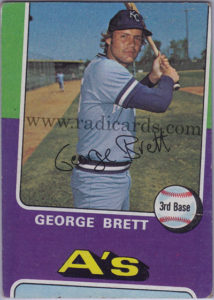
Throughout history, we’ve seen some interesting manufacturing defects. We’ve discussed a few of them, you can find them in the Errors category. Let’s take a moment to discuss miscut baseball cards and why they were more common in the silver age of baseball card manufacturing in comparison to today’s bronze and steel age counterparts. Let’s rewind back to 1957. This was an important year for the hobby because it signified the beginning of card size standardization. Before 1957, cards were inconsistently sized. Beginning in 1957, Topps adjusted the size to 2.5? x 3.5? which became the industry standard. Upon standardizing the size, noticeable defects still occurred. Due to sub-par quality control standards, Topps and other companies experienced high probability of miscutting the printing sheets. Some sheets were even mismatched leaving some fronts being printed on wrong backs. Miscuts occurred frequently in the 1960’s and although the probability of errors decreased with time, the 80’s were rampant with wrong backs/fronts, missing backs/fronts. The standards for quality in the manufacturing process got significantly better in the 90’s but as we can see by the ’90 Leaf Sosa, even premium products experience defects. It’s likely and almost expected with high print runs. There’s a positive correlation between level of print run and probability of defects. The more you print, the more likely you are to have a percentage of defects.
Originally developed by Motorola in 1981, Six Sigma (6ó) is a business management strategy that aims to improve the quality of output process standards by identifying and minimizing/removing any causes of defects. Additionally, Six Sigma seeks to minimize variability in the manufacturing process flow. The optimal goal is 100% quality output.
Let’s consider the following graph:

This graph depicts optimal conformance rates. The specification range lands within a 99.99% confidence interval. The lower specification or control limit (LSL/LCL) and upper specification or control limit (USL/UCL) stop at .001 parts per million (ppm). This means that in order to maintain a 99.99% confidence level (6ó) in the production process, for every 1,000,000 (1MM) widgets produced, only .001 are allowed to be defective. Keep in mind, this is the goal of the production process. In contrast to 99.99% confidence, the old industry standard was 3ó which sits closer to a 67% confidence interval, while although high, allows 1350 ppm to be defective.

Most, if not all companies should strive for 6ó. This will allow for minimal possible defects. Ideally, the firm should aim for a 100% confidence rate but given the high levels of output, some percentage of defects is always possible, if not expected to some degree. It’s almost impossible to completely phase out any chance of a defect, however, the firm’s goal should be to minimize that probability.
The connection between 6ó and miscut baseball cards is as such. These miscuts account for the small percentage that fall outside of 99.99% confidence interval. What this means is that these cards represent those parts per million (ppm) that were defective and somehow still made it into circulation. Manufacturing inspections aside, defects like these aren’t found nearly as often in today’s’ market due in part by higher quality standards during the production phase (i.e., 6ó). It’s simple really, the more quality output you have, the less money you waste on replacements and the better off you’ll be financially. In addition, the more consistent your production rate is, the higher probability of creating and maintaining consumer loyalty. Miscuts hold low demand and are worth significantly less than their ideally cut counterparts. Low value = low demand = lost profits = bankrupt. In order to avoid product this dilemma, it’s critical to maintain optimal production control and quality standards during the manufacturing phase. On the other hand, that ’82 Topps George Brett card is rather droll.
To see the current eBay auctions for miscut sports cards, click here.

 Have you visited our store? Click here.
Have you visited our store? Click here.



I think this is important information for the common collector to understand. I would like to read your thoughts on vintage cards, graded cards and autographed memorabilia. What do you think of investing in Strasburg?
Investing in a pitcher is extremely risky. Remember Brien Taylor?
Haha, that’s actually an interesting comment Tim given the origin of B.Taylor’s injury. I’m still convinced that had he not been at that bar that night, he would have made a great pitcher. Thoughts?
Reports are saying Strasburg has some minor injuries. However, coaching staffs are being careful with their young pitching talent now, so who knows what’s really going on. Great info, Pat. Send your resume to a big card company and try to get a job with them. Put your knowledge to good use!
According to the latest news reports, Strasburg is out for the season. I think he’s an incredible talent but needs to perhaps tone it down from time to time. The kid consistently throws 100mph. Longevity can potentially be compromised with that type of consistent power. He’ll be back upon recovery, I’m just concerned with how his being on the DL is going to affect market demand withing the hobby. Time will tell.
Wasn’t that the problem of Kerry Wood?
and Mark Prior?
Haha! I haven’t, should I?
Pat have you Sent your Six Sigma info to Upper Deck? I feel like those clowns at Sea Otter Place have never taken a business/finance class.